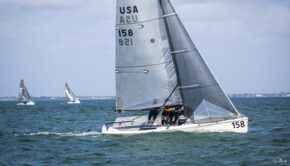A view from the middle of the pack
Published on September 11th, 2014
The Viper 640 North American Championship was brought west for the first time in class history, and the fleet was welcomed with near perfect conditions in Long Beach, CA. The wind was epic as 34 boats marched around the racecourse hitting speeds of 15+ knots. Keith Magnussen, active in the class’ California growth, shares his lessons learned…
Usually we hear about the top end of the fleet but I wanted to share what it was like from the middle of the pack.
Craig Walker purchased a Viper 640 last year and has been working hard to get his sailing skills sharpened. As Craig was still a newbie to driving and racing a boat, our event goal was to be competitive, learn, not make too many mistakes, and have a great time.
We were greeted with big wind and waves, and as this was Craig’s first big time race, we talked about being conservative. This is a good tactic in a large fleet when the driver is not super comfortable at trying to cross boats on a full plane!
I also learned a few things about managing myself in the situations that arose. The more calm I was, the calmer Craig was. Of course, this was also true on the opposite end. I had my moments when my emotions got the better of me, usually at a leeward mark rounding when we were coming in on port fully planing.
With 34 boats zipping around the course, it was important to keep Craig comfortable. Avoiding port laylines and ensuring we were in commanding positions became crucial. It is amazing how much better we did when we sailed away from the riff-raff.
The final day came and with three races left we had a goal to be in the top 20 and beat the boats around us. Craig was getting better with every tack, with the flow of speed input helping him keep the boat on its rails. One thing that worked well was being a little over layline at the weather mark. The final day saw a lot of boats trying to push the laylines which resulted in collisions and people hitting the mark. We would pass 5-7 boats by coming in high with speed and going over everyone.
Working with our newbie in 20-25 knots of wind makes for some exciting and almost dangerous downwind legs. We were cautious in setting and used the blow through gybes to keep us safe. We only had a few crashes and were able to recover rather quickly with a release of the spinnaker halyard. It is very intense doing 14 knots into a leeward mark… you definitely need your ‘you know what’ together.
In the end we had an amazing time. We all learned and had fun which is what this sport is about… right?








 We’ll keep your information safe.
We’ll keep your information safe.